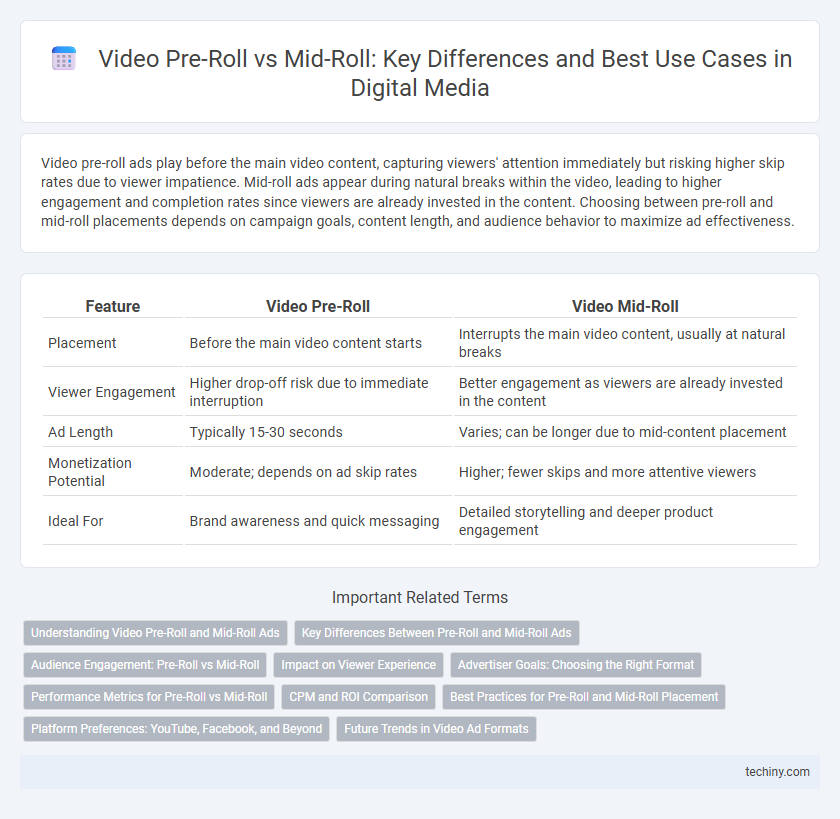Video pre-roll ads play before the main video content, capturing viewers' attention immediately but risking higher skip rates due to viewer impatience. Mid-roll ads appear during natural breaks within the video, leading to higher engagement and completion rates since viewers are already invested in the content. Choosing between pre-roll and mid-roll placements depends on campaign goals, content length, and audience behavior to maximize ad effectiveness.
Table of Comparison
| Feature | Video Pre-Roll | Video Mid-Roll |
|---|---|---|
| Placement | Before the main video content starts | Interrupts the main video content, usually at natural breaks |
| Viewer Engagement | Higher drop-off risk due to immediate interruption | Better engagement as viewers are already invested in the content |
| Ad Length | Typically 15-30 seconds | Varies; can be longer due to mid-content placement |
| Monetization Potential | Moderate; depends on ad skip rates | Higher; fewer skips and more attentive viewers |
| Ideal For | Brand awareness and quick messaging | Detailed storytelling and deeper product engagement |
Understanding Video Pre-Roll and Mid-Roll Ads
Video pre-roll ads appear before the main video content, capturing viewer attention immediately and driving early engagement with a high completion rate. Mid-roll ads play during natural breaks in longer videos, offering better viewer retention by delivering messages when users are already invested in the content. Both formats optimize ad exposure and brand recall, but choosing between pre-roll and mid-roll depends on video length, viewer intent, and campaign objectives.
Key Differences Between Pre-Roll and Mid-Roll Ads
Pre-roll ads play before the main video content, capturing viewer attention early but often experiencing higher skip rates due to user impatience. Mid-roll ads appear during video breaks, capitalizing on engaged viewers but risking interruption of the content experience. Key differences include placement timing, viewer engagement levels, and potential ad effectiveness based on content type and platform algorithm.
Audience Engagement: Pre-Roll vs Mid-Roll
Video pre-roll ads typically generate higher initial viewer engagement due to their position before content playback, capturing attention while audiences are freshly focused. Mid-roll ads, appearing during the content, tend to face viewer drop-off but can achieve deeper engagement with highly relevant or targeted ads interrupting natural content flow. Audience retention rates for mid-roll placements are often lower, yet they benefit from longer exposure times, influencing overall ad recall and brand recognition more effectively.
Impact on Viewer Experience
Video pre-roll ads often lead to higher viewer frustration due to their interruption before the content begins, negatively impacting engagement rates. Mid-roll ads can disrupt the narrative flow, causing viewers to lose focus or abandon the video, but they tend to yield better recall and ad effectiveness. Balancing ad placement with content length and relevance is crucial to optimizing viewer experience and maximizing advertising performance in digital media.
Advertiser Goals: Choosing the Right Format
Video pre-roll ads engage viewers immediately, boosting brand awareness and maximizing reach before content consumption, making them ideal for advertisers aiming for high visibility. Mid-roll ads, appearing during content breaks, enhance viewer retention and improve ad recall by targeting engaged audiences, which benefits advertisers focused on deepening message impact. Selecting the right format depends on campaign objectives: pre-rolls suit broad exposure goals, while mid-rolls drive stronger engagement and conversion rates.
Performance Metrics for Pre-Roll vs Mid-Roll
Video pre-roll ads typically yield higher view-through rates (VTR) due to their placement before content begins, capturing audience attention when engagement is fresh. Mid-roll ads often generate increased completion rates and viewer retention metrics since they appear within content, reducing ad skip rates during active consumption. Performance insights reveal that pre-roll drives broader reach, while mid-roll supports deeper engagement, influencing campaign optimization based on targeting strategy.
CPM and ROI Comparison
Video pre-roll ads typically command higher CPM rates due to their placement before content, engaging viewers with guaranteed full attention, whereas mid-roll ads often yield better ROI by benefiting from viewer investment during longer content sessions. Mid-roll placements capitalize on increased viewer engagement and completion rates, leading to improved conversion metrics despite slightly lower CPM costs. Advertisers seeking efficient budget allocation should weigh pre-roll's premium visibility against mid-roll's superior audience retention and actionable outcomes.
Best Practices for Pre-Roll and Mid-Roll Placement
Effective video pre-roll placement maximizes viewer retention by keeping ads under 15 seconds and aligning content with audience interests to reduce skip rates. Mid-roll ads perform best when inserted at natural breaks or high-engagement points within the content, ideally after 20-30% of video completion to maintain viewer attention without causing disruption. Leveraging viewer data and analytics ensures optimal timing and frequency, enhancing ad recall and overall campaign performance in digital media.
Platform Preferences: YouTube, Facebook, and Beyond
YouTube primarily favors mid-roll ads for longer videos, enhancing viewer engagement without causing early drop-offs, while Facebook leans towards video pre-roll ads to maximize reach across varied content lengths. Platforms like TikTok and Instagram prioritize shorter pre-roll ads tailored to vertical video formats, optimizing for mobile user behavior. Understanding these platform-specific ad placements is crucial for optimizing digital media campaigns and driving higher ROI in video advertising.
Future Trends in Video Ad Formats
Video pre-roll ads, traditionally positioned before content, and mid-roll ads inserted during playback, are evolving with advancements in AI-driven personalization and interactivity. Future trends indicate a shift towards immersive video ad formats, such as shoppable videos and augmented reality overlays, which enhance viewer engagement and increase conversion rates. Programmatic technology integration will further optimize ad delivery timing and relevancy, improving advertiser ROI and audience retention.
Video Pre-Roll vs Mid-Roll Infographic

 techiny.com
techiny.com